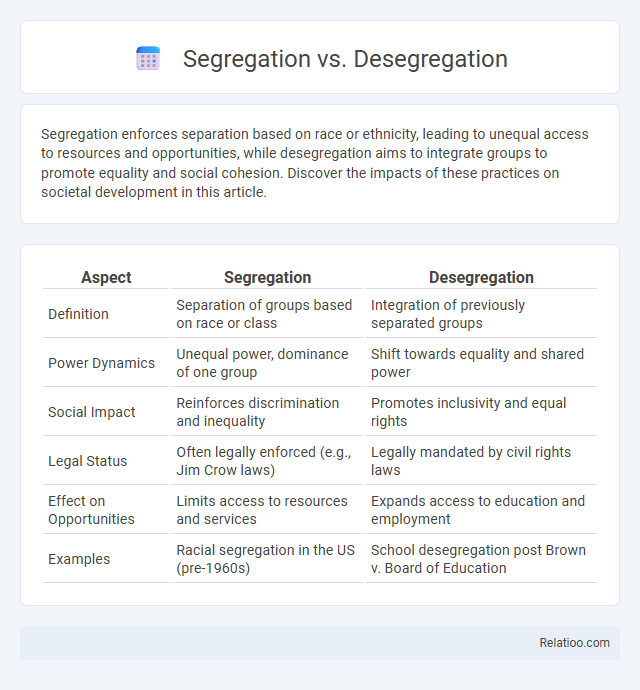Segregation enforces separation based on race or ethnicity, leading to unequal access to resources and opportunities, while desegregation aims to integrate groups to promote equality and social cohesion. Discover the impacts of these practices on societal development in this article.
Table of Comparison
| Aspect | Segregation | Desegregation |
|---|---|---|
| Definition | Separation of groups based on race or class | Integration of previously separated groups |
| Power Dynamics | Unequal power, dominance of one group | Shift towards equality and shared power |
| Social Impact | Reinforces discrimination and inequality | Promotes inclusivity and equal rights |
| Legal Status | Often legally enforced (e.g., Jim Crow laws) | Legally mandated by civil rights laws |
| Effect on Opportunities | Limits access to resources and services | Expands access to education and employment |
| Examples | Racial segregation in the US (pre-1960s) | School desegregation post Brown v. Board of Education |
Understanding Segregation: Definition and Historical Context
Segregation refers to the enforced separation of different racial or social groups in daily life, particularly prevalent in the United States during the Jim Crow era, where African Americans were systematically excluded from public facilities and services. Desegregation marks the legal and social process of ending this separation, aimed at promoting equal access and integration through landmark decisions like Brown v. Board of Education. Understanding your role in recognizing the historical context of segregation helps in appreciating the ongoing challenges and progress related to social equality and civil rights.
The Roots of Segregation: Causes and Implementation
The roots of segregation stem from systemic racism, economic inequality, and social prejudices enforced through laws and policies like Jim Crow laws and redlining. Segregation was implemented by legal mandates, discriminatory housing practices, and unequal access to public services, reinforcing racial divides. Desegregation efforts, epitomized by the 1954 Brown v. Board of Education Supreme Court ruling, sought to dismantle these structures but faced resistance, highlighting the deep entrenchment of segregation's causes.
Effects of Segregation on Society and Individuals
Segregation enforces systemic division by race, ethnicity, or social class, leading to unequal access to education, employment, and housing, which entrenches economic disparities and social injustices. The effects of segregation on society include increased social tensions, reduced economic growth, and persistent cycles of poverty and discrimination that inhibit collective progress. Your understanding of these impacts highlights the critical need for desegregation efforts to promote equity, social cohesion, and inclusive development.
The Genesis of Desegregation Movements
The genesis of desegregation movements originated from widespread social, political, and legal challenges against systemic segregation policies that enforced racial divisions in education, transportation, and public spaces. Your understanding of key events such as the Brown v. Board of Education decision in 1954 highlights how desegregation efforts dismantled legalized racial segregation by declaring it unconstitutional. These movements aimed to replace segregation with inclusive integration, promoting equal rights and social justice across communities.
Landmark Events in Desegregation History
The Brown v. Board of Education Supreme Court decision in 1954 marked a pivotal moment in desegregation history by declaring racial segregation in public schools unconstitutional, overturning the "separate but equal" doctrine established by Plessy v. Ferguson. The 1957 Little Rock Nine crisis further highlighted desegregation efforts as nine African American students faced violent opposition when integrating Central High School in Arkansas under federal troop protection. The Civil Rights Act of 1964 legally enforced desegregation across public spaces and employment, dismantling institutional segregation and promoting equal rights nationwide.
Comparing Segregation and Desegregation: Key Differences
Segregation enforces the separation of groups based on characteristics such as race, resulting in unequal access to resources and opportunities, while desegregation aims to eliminate these divisions by promoting integration and equal treatment. Your understanding of segregation highlights systemic barriers, whereas desegregation represents efforts to dismantle those barriers through laws, policies, and social change. The key difference lies in segregation maintaining separation and inequality, whereas desegregation focuses on creating inclusive environments where diverse groups coexist.
Social, Economic, and Psychological Impacts of Desegregation
Desegregation significantly transforms social dynamics by fostering inclusivity and reducing racial barriers, which promotes greater social cohesion and mutual understanding. Economically, it opens diverse job opportunities and access to resources, narrowing income disparities and enhancing community wealth. Your psychological well-being can improve as desegregation reduces feelings of isolation and discrimination, leading to increased self-esteem and mental health stability.
Ongoing Challenges: Modern-Day Segregation
Modern-day segregation persists in housing, education, and employment, driven by economic disparities and systemic biases that limit access to opportunities. Your community may face invisible barriers reinforcing separation despite legal desegregation efforts, impacting social mobility and equality. Addressing these ongoing challenges requires targeted policies and awareness to dismantle structural inequalities that perpetuate segregation today.
Lessons Learned: The Legacy of Segregation and Desegregation
The legacy of segregation reveals systemic inequalities that profoundly shaped educational and social structures, emphasizing the importance of equitable access and civil rights. Desegregation efforts highlighted challenges in policy enforcement and community resistance, underscoring the necessity for sustained advocacy, inclusive curricula, and cultural sensitivity in addressing racial disparities. Lessons learned from this historical context advocate for proactive measures to prevent re-segregation, promote diversity, and ensure equal opportunity across all institutions.
Building Inclusive Societies: The Path Forward
Segregation entrenches social divisions by separating groups based on race, ethnicity, or other characteristics, hindering equal opportunities and social cohesion. Desegregation seeks to dismantle these barriers by promoting integrated spaces where diverse groups coexist, fostering mutual understanding and equity. Building inclusive societies requires moving beyond mere desegregation towards proactive policies that encourage genuine inclusion, equity, and participation across all community sectors.

Infographic: Segregation vs Desegregation
 relatioo.com
relatioo.com